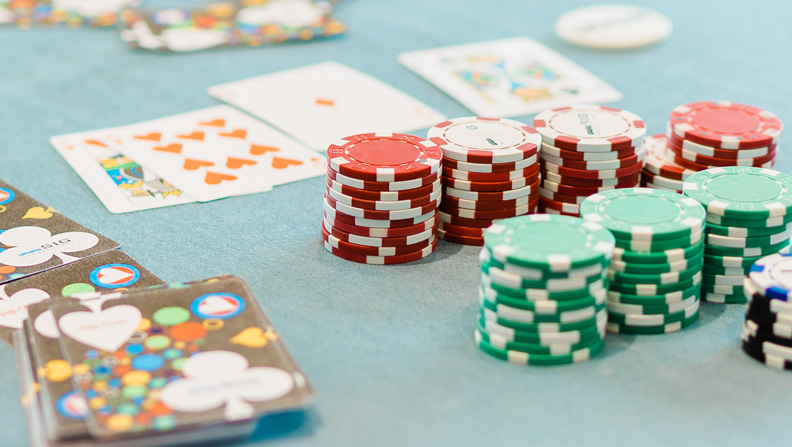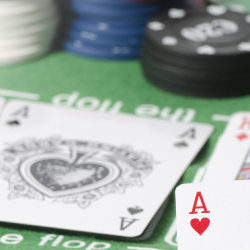
If you’re unfamiliar, check out a brief primer on the Stud 8 rules.
Recently in Susquehanna’s training class, there was a hand of 7 Card Stud/8-or-Better that had an interesting play worth discussing. This is a high/low game, where the best 5-card poker hand out of 7 cards wins half the pot, and the best low hand (that has no card higher than an 8, and no pairs) wins the other half of the pot. Straights and flushes do not count against the low hand. If there are no low hands, the high hand wins the whole pot.
There were 7 people playing the hand. The 4♣ (who we will call Player A) was the forced bet, or the “bring-in,” followed by a 5♣ (folded), Q♦ (raised – we’ll call him Player B), 10♣ (folded), 10♦ (folded), 9♥ (folded), K♠ (folded), and Kh (folded). Player A held 72 as his hole cards, giving him a potential low hand against the raising Q, so he called.
After fourth street, the boards were xxQ♥J♣ vs (27)4♣7♥. Player B bet out, and Player A called.
Fifth street paired both hands; the boards were now xxQ♦J♣J♦ vs (27)4♣7♥7♦. The original low draw turned into three-of-a-kind for Player A, who has every reason to believe this is the best hand at this point. Player B bet out, and Player A raised. Player B decided to call at this point.
Sixth street looked like no improvement for either hand; boards were now xxQJJ3 vs (27)477T. Player B checked (as you would expect after he had just been raised on 5th street), and Player A bet out. Player B hand then raised. Take a moment here to think about what you would do if you were Player A and had the 477T hand.
Player A re-raised (making it three bets now), figuring that his three-of-a-kind was a pretty powerful holding in this spot, especially since he thought his opponent had two pair, Queens and Jacks. This is the decision that merits some examination.
One of the important aspects of playing winning poker is being able to not only make an initial assessment of an opponent’s holdings (or range of hands an opponent could have), but also adjusting that assessment based on the opponent’s actions. This is referred to as Bayesian updating; what hand (or range of hands) do I think he is holding given the way he has acted.
This decision is particularly difficult, because you also have to think about what the opponent would think your range of hands could be. (Be careful digging too deeply into this iterative chain of thought; it is turtles all the way down.) In this case, it seems pretty clear that Player A’s most likely hand is three-of-a-kind. During the hand, though, Player A did not think that was the case; he thought there was a chance Player B may have thought he raised on 5th street with a pair and a low draw. The problem with this thinking, though, is that Player B knows that if Player A had a low draw, he had not yet made his low; the Ten on 6th street would have been exactly the card that he would have wanted to avoid with that draw, so he would take a free card to see the river. Likewise, given that the most likely hand that Player B has on 5th street is two-pair, with an overcard to the pair they see, it would likely not be profitable for a pair and a low draw to raise here, anyway. (The exceptions are if one of the low cards is an Ace, in which case this is about a 50/50 play, or if the low cards are an open straight draw, like 56 in the hole, giving a hand like 45677, which can catch cards that give the holder the entire pot, giving this hand about a 5:4 edge in equity.)
From the range of hands that Player A could have raised on 5th street, the only one that Player B could expect would bet again on 6th street is the three-of-a-kind. In order for Player B to check and then raise, his most likely hand is three Jacks or better. (Since we know he has two Jacks showing, “better” here means Jacks-full-of-Queens, Queens-full-of-Jacks, 3s-full-of-Jacks, Jacks-full-of-3s, or four Jacks.) Against any of the possible holdings of the opponent, the actual hand (27477T) either only has 1 card to win (the last 7 in the deck), or 7 cards to win (if the opponent has the 3s-full-of-Jacks hand or three Jacks, and both of these hands can improve if the opponent catches another Jack).
The actual outcome of the hand does not matter (though it is worth noting in this case that Player B did, in fact, have a full house already, and made the right decision to re-raise). The important point is to readjust your read after you get the additional information of the opponent’s actions. Poker is a game of asymmetric information, but you can deduce a lot of the information that another player has from the way they play their hand.




Subscribe Now
Get each new post sent straight to your inbox